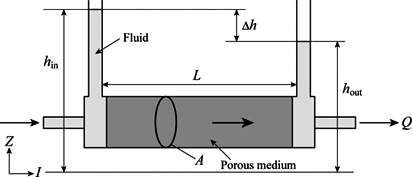Darcy’s law
- Darcy’s law states that the discharge or rate of flow per unit time is proportional to hydraulic gradient
V ∝ i OR V = Ki
- Darcy’s law describes the relationship between the instantaneous rate of discharge through a porous medium and pressure drop at a distance.
Darcy’s law is expressed as:
V ∝ i OR V = Ki
i = dh/dl
Q = VA
q = Q/A = -K*(dh/dl)
Where,
q = The discharge rate
Q = The rate of water flow
K = The hydraulic conductivity
A = The column cross-section area
dh/dl = A hydraulic gradient
Limitations of Darcy’s law
- Darcy’s law is generally valid only when the flow is laminar i.e when the reynold’s number is less than on equals to 1. (Re ≤ 1)
- Darcy’s law is valid only for laminar flow, but not for turbulent flow.
- Darcy’s law is valid only for clay, silt and sand and not for gravels, cobbles etc. This is because the flow is always turbulant.
Click Here For Free Civil Engineering Study Materials

